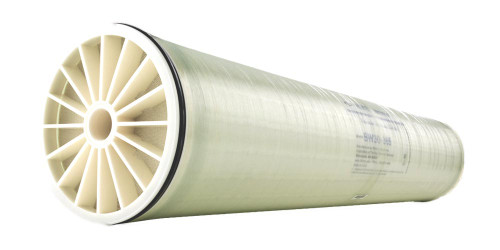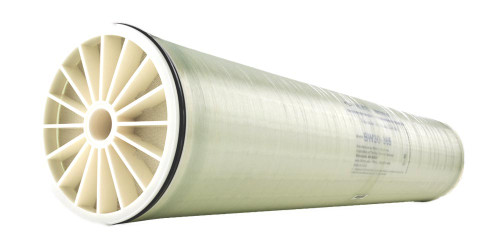The DOW FILMTEC NF270-400 element is designed to remove a high percentage of TOC and THM precursors while having a medium to high salt passage and medium hardness passage. It is an ideal element for surface and groundwater applications where good organic removal is desired with partial softening in order to maintain a minimum level of hardness for organoleptic properties and preservation of distribution networks. The high active area membrane combined with low net driving pressure of the membrane allows the removal of these compounds at low operating pressure.
Advantages
- Good organic (NOM) removal
- Partial softening preserves water character
- High flux results in high yields
- Filmtec performance and quality
Important Information
Proper start-up of reverse osmosis water treatment systems is essential to prepare the membranes for operating service and to prevent membrane damage due to overfeeding or hydraulic shock. Following the proper start-up sequence also helps ensure that system operating parameters conform to design specifications so that system water quality and productivity goals can be achieved.
Before initiating system start-up procedures, membrane pretreatment, loading of the membrane elements, instrument calibration and other system checks should be completed.
Please refer to the application information literature entitled “Start-Up Sequence” (Form No. 609-02077) for more information.
Operation Guidelines
Avoid any abrupt pressure or cross-flow variations on the spiral elements during start-up, shutdown, cleaning or other sequences to prevent possible membrane damage. During start-up, a gradual change from a standstill to operating state is recommended as follows:
- Feed pressure should be increased gradually over a 30-60 second time frame.
- Cross-flow velocity at set operating point should be achieved gradually over 15-20 seconds.
- Permeate obtained from first hour of operation should be discarded.
General Information
- Keep elements moist at all times after initial wetting.
- If operating limits and guidelines given in this bulletin are not strictly followed, the limited warranty will be null and void.
- To prevent biological growth during prolonged system shutdowns, it is recommended that membrane elements be immersed in a preservative solution.
- The customer is fully responsible for the effects of incompatible chemicals and lubricants on elements.
- Maximum pressure drop across an entire pressure vessel (housing) is 50 psi (3.4 bar).
- Avoid permeate-side backpressure at all times.
Specifications
| Product | GMID | Nominal Active Surface Area ft2(m2) | Product Water Flow Rate gpd (m3/d) | Stabilized Salt Rejection (%) | ||
|---|---|---|---|---|---|---|
| ft2 | (m2) | gpd | (m3/d) | |||
| NF270-400 | 148822 | 400 | (37) | 12,500 | (47.3) | 97 |
- The DOW FILMTEC™ NF270-400 element is a high area, high productivity element designed to remove a high percentage of TOC and THM precursors while having a medium to high salt passage; medium hardness passage.
- The DOW FILMTEC NF270-400 element is an ideal element for surface and ground water applications where good organic removal is desired with partial softening in order to maintain a minimum level of hardness for organoleptic properties and preservation of distribution networks.
- The high active area membrane combined with low net driving pressure of the membrane allows the removal of these compounds at low operating pressure.
Operating Limits
- Membrane Type Polyamide Thin-Film Composite
- Maximum Operating Temperature 113°F (45°C)
- Maximum Operating Pressure 600 psig (41 bar)
- Maximum Pressure Drop 15 psig (1.0 bar)
- pH Range, Continuous Operation 3 - 10
- pH Range, Short-Term Cleaning (30 min.) 1 - 12
- Maximum Feed Flow 70 gpm (15.9 m3/hr)
- Maximum Feed Silt Density Index SDI 5
- Free Chlorine Tolerance <0.1 ppm
- Production of municipal drinking water
-
Best price
Productive items that did the job well
 ENGLISH
ENGLISH ESPAÑOL
ESPAÑOL العربية
العربية PORTUGUÉS
PORTUGUÉS FRANÇAIS
FRANÇAIS










